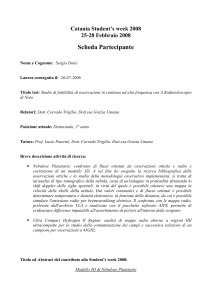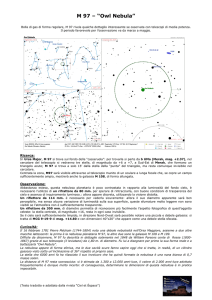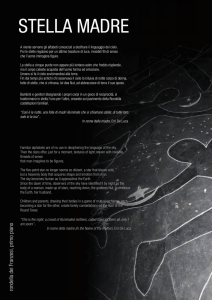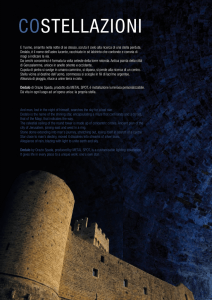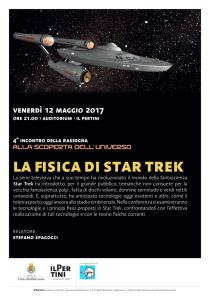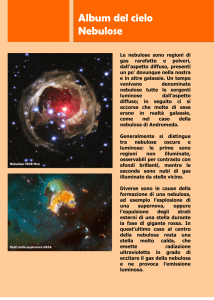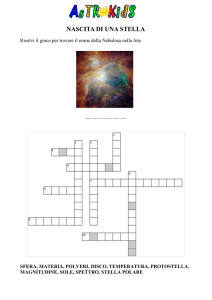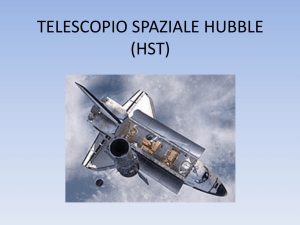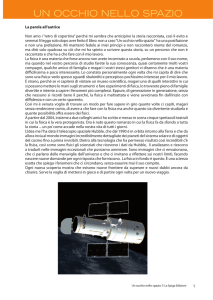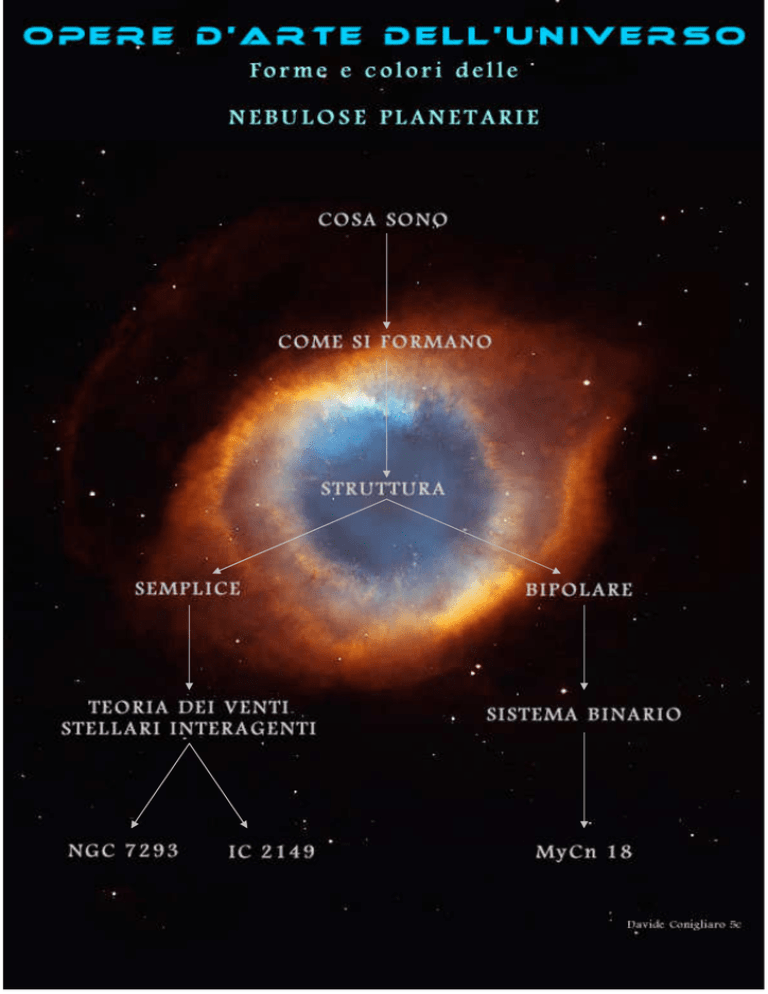
OPERE D’ARTE
DELL’UNIVERSO
Forme e colori delle nebulose planetarie
Nebulose Planetarie
Il termine “Nebulosa Planetaria” risale a due secoli fa, e si deve a un’interpretazione errata
dell’astronomo inglese William Herschel. La forma vagamente tondeggiante di molte di queste
strutture ricordò a Herschel il disco verdastro di Urano(di cui era stato lo scopritore) e lo portò a
pensare che si trattasse di sistemi planetari, che prendevano forma attorno a giovani stelle. Il nome
rimase, anche se si scoprì, che era vero il contrario: questo tipo di nebulosa è costituita dal gas
espulso da una stella morente, e non rappresenta il passato, ma il futuro. Tra cinque miliardi di anni,
o giù di li anche il Sole concluderà la sua esistenza cosmica nell’elegante violenza di una nebulosa
planetaria.
Come tutte le grandi espressioni artistiche, le nebulose planetarie non si limitano ad
affascinarci, ma ci costringono anche a mettere in dubbio la nostra percezione del mondo. Nel caso
specifico, sfidando la teoria dell’evoluzione stellare, il modello che descrive l’arco vitale della vita
delle stelle. Questa teoria è un ramo maturo della scienza, uno dei fenomeni su cui si basa tutta la
comprensione del cosmo, ma non riesce a spiegare le complesse figure che compaiono nelle
immagini di Hubble. Se le stelle nascono sferiche, vivono sferiche e muoiono sferiche, come fanno
a disegnare strutture così elaborate da somigliare a una formica, a una stella marina o all’occhio di
un gatto?
Giganti rosse e nane bianche
Nell’ultimo secolo gli astronomi hanno compreso che al momento della loro morte le stelle
si dividono in due classi distinte. Quelle che appartengono all’elite delle stelle massicce –
dimensioni superiori a otto masse solari – esplodono improvvisamente come supernove. Le stelle
più piccole come il Sole, muoiono lentamente e, anziché detonare, consumano l’ultima fase della
loro esistenza bruciando spasmodicamente il loro combustibile nucleare, un pò come un motore
d’automobile che sta finendo la benzina.
Le reazioni nucleari nel cuore delle stelle di questa ultima classe, reazioni che le hanno
alimentate per quasi tutta la vita, esauriscono tutto l’idrogeno disponibile, poi l’elio. Man mano che
la reazione nucleare si sposta all’esterno, verso il materiale fresco del guscio che circonda il nucleo,
la stella si gonfia, fino a diventare una “gigante rossa”. Quando si esaurisce anche l’idrogeno del
guscio, la stella inizia a fondere l’elio, e in questo processo diventa instabile. Convulsioni profonde,
combinate con la pressione della radiazione e altre forze, scagliano nello spazio gli strati
superficiali, dando vita a una nebulosa planetaria.
Le nebulose planetarie non sono però così ariose e tranquille come suggeriscono le loro
immagini: al contrario, sono massicce e tempestose. Ciascuna di esse contiene l’equivalente di circa
un terzo della massa del Sole, compreso quasi tutto il combustibile nucleare inutilizzato. All’ inizio
gli strati superficiale della stella sono espulsi a una velocità compresa fra i 10 e 20 chilometri ala
secondo, un flusso relativamente lento, che trasporta la maggior parte della massa finale della
nebulosa. Man mano che la stella si spoglia fino a scoprire il nucleo ancora caldo, il suo colore
passa dall’arancione al giallo, poi al bianco e infine al blu. Quando la temperatura della superficie
supera i 25.000 Kelvin, la stella sommerge i gas circostanti di una intensa luce ultravioletta,
abbastanza potente da smembrare le molecole e strappare gli elettroni dagli atomi. Il vento stellare
trasporta una massa via via inferiore, ma a una velocità sempre più alta. Dopo un periodo di durata
variabile fra 100.000 anni e un milione, a seconda della massa originaria, il vento si placa del tutto,
e la stella diventa una “nana bianca” estremamente densa e calda: un tizzone ardente stellare che la
gravità ha compresso fino a farne una sfera delle dimensioni della Terra.
Poiché le forze che espellono la massa dalle stelle morenti hanno simmetria sferica, almeno
secondo la teoria più accreditata, fino agli anni ottanta gli astronomi hanno pensato che le nebulose
planetarie fossero bolle sferiche in espansione. Da allora, però, lo scenario si è fatto sempre più
complicato. E sempre più interessante.
Venti stellari
Il primo indizio che le nebulose planetarie fossero qualcosa di più che semplici rigurgiti
stellari risale al 1978, quando le osservazioni nell’ultravioletto mostrarono che il vento delle stelle
morenti continua a soffiare anche molto tempo dopo l’espulsione degli stati gassosi più esterni. I
gas sono molto rarefatti, ma questi venti raggiungono velocità di 1000 chilometri al secondo, cento
volte superiori a quelle dei venti più densi che li precedono.
Per spiegare gli effetti di questi venti, è stato preso in prestito un modello dei venti stellari
elaborato per spiegare altri fenomeni astrofisica. Secondo questa ipotesi, quando i venti rapidi si
scontrano con quelli più lenti espulsi in precedenza, nel punto di incontro si forma un denso bordo
di gas compressi. Questo anello tridimensionale di gas, più precisamente “toro”, circonda una cavità
quasi vuota (ma estremamente calda); con il tempo, il vento veloce svuota un volume di spazio
sempre più grande.
Questo modello, detto “ipotesi dei venti stellari interagenti”, funziona bene per le strutture
sferiche o quasi sferiche. Ma negli anni ottanta si cominciò a capire che le nebulose planetarie
sferiche sono un’eccezione: probabilmente sono solo il dieci percento del totale. Molte altre hanno
forme allungate, a uova, mentre le più spettacolari, anche se più rare, presentano due bolle sui lati
opposti della stella morente. Gli astronomi le chiamano “bipolari”, anche se sarebbe più corretto, e
più vivido, definirle “a farfalla” o “a clessidra”.
Per spiegare queste forme si è allargato il concetto dei venti interagenti. Supponiamo che i
venti meno veloci riescano a formare un denso anello che ruota attorno all’equatore della stella. In
un secondo momento, l’anello toro defletterà debolmente i venti stellari verso i poli, dando origine a
una nebulosa ellittica. Le nebulose a forma di clessidra, sono quelle con un anello molto leggero e
molto denso, che funziona come un ugello, un po’ come fanno le labbra quando fischiamo, facendo
convergere il fiato in un sottile getto d’aria. Analogamente, gli anelli che deflettono con forza i
venti veloci, produrranno una coppia speculare di getti, o flussi di gas, a forma di clessidra.
Il modello era semplice e spiegava bene tutte le immagini disponibili fino al 1993. Le
simulazioni al computer confermavano la validità dell’idea di base, mentre nuove osservazioni
testimoniavano che i venti meno rapidi sembravano realmente più densi vicino all’equatore.
Nel 1994 Hubble scattò la sua prima fotografia chiara di una nebulosa planetaria, la Occhio
di Gatto (ufficialmente classificata come NCG 6543): un’immagine fatale, sconvolgente. Una delle
due ellissi incrociate, un bordo sottile che circonda una cavità a forma di ellisse, corrispondeva al
modello, ma che cosa erano le altre strutture? Nessuno aveva previsto le indistinte regioni rossastre
che legavano la nebulosa, e i filamenti simili a getti erano ancora più strani. Nella migliore delle
ipotesi il modello è valido solo in parte.
Teorici in un mare di guai
Non è sempre facile rinunciare a un’ipotesi scientifica che sembrava funzionare, per cui
sperammo che l’Occhio di Gatto fosse un’anomalia. Non lo era. Presto arrivarono altre immagini di
Hubble che toglievano ogni dubbio: nella nostra ricostruzione della morte stellar mancavano alcuni
elementi fondamentali. A parte l’ego ferito, era una situazione ideale per dei ricercatori. Quando le
idee a cui siete affezionati sono finite in pezzi, la natura vi sta sfidando a ricominciare a osservare:
che cosa ti è sfuggito? A che cosa hai trascurato di prestare attenzione?
In situazioni simili, bisogna concentrarsi sui casi estremi, perché sono quelli in cui le forze
sconosciute operano con più evidenza. Tra le nebulose planetarie, i casi più estremi sono gli oggetti
bipolari. Le strutture più piccole che ornano le nebulose sono speculari, una su ciascun lato della
nebulosa. E questa simmetria significa che l’intera struttura è stata assemblata in modo coerente da
processi organizzati che operano in prossimità della superficie della stella, un po’ come accade
quando si forma un fiocco di neve.
Per questi oggetti il modello dei venti interagenti fa una previsione che è facile verificare:
una volta che il gas ha lasciato l’anello, viaggia verso l’esterno a velocità costante, producendo un
particolare spostamento Doppler della luce emessa dal gas. Ebbene, non è così. Nel 2000 il gruppo
di Romano Corradi, che ora lavora ai telescopi Isaac Newton, alle Canarie, ha studiato con Hubble
la nebulosa del Granchi Australe (He2-104), scoprendo che la velocità di espansione, cresce in
proporzione alla distanza dalla stella. I gas più lontani erano li semplicemente perché si muovevano
più velocemente. Risalendo indietro nel tempo, l’incantevole nebulosa a clessidra sembra essersi
formata circa 5700 anni fa in una singola eruzione. Il modello dei venti interagenti, che presume un
vento costante che modella la nebulosa, era insostenibile. Ancora più strana è stata un’altra scoperta
di Corradi e colleghi: la nebulosa del Granchi Australe è costituita in realtà da due nebulose, una
dentro l’altra come le bambole di una matrioska. Immaginammo che la nebulosa più interna fosse
semplicemente la più giovane delle due, ma le osservazioni hanno mostrato con chiarezza che
entrambe le nebulose avevano lo stesso andamento di velocità crescenti con la distanza. L’intera
complessa struttura doveva essersi formata in un evento molto scenografico, avvenuto sei millenni
fa. Ma su questa scoperta ci stiamo arrovellando ancora oggi.
Rimescolare le carte
I primi, promettenti abbozzi di teorie sulla formazione delle nebulose planetarie non
mancano: il difficile è sviluppare modelli che abbraccino tutte le osservazioni. Oggi si concorda sul
fatto che uno dei principali fattori in gioco è l’influsso gravitazionale di stelle compagne. Almeno la
metà delle “stelle” che si vedono di notte sono in realtà sistemi binari, in cui due oggetti orbitano
attorno a un comune centro di massa. Nella maggior parte di questi sistemi le stelle sono così
lontane da svilupparsi in modo indipendente ma in una piccola frazione di casi la gravità di una
stella può deflettere o persino catturare il materiale che fluisce dall’altra. Questa frazione
corrisponde al numero di nebulose planetarie bipolari.
Nel loro scenario, la compagna cattura il materiale che fluisce da una stella morente. In un
sistema in cui le orbite sono più piccole di quelle di Mercurio e un anno si misura in giorni terrestri,
questo trasferimento è macchinoso. Quando il materiale della stella morente raggiunge la
compagna, quest’ultima si è portate ben avanti nella sua orbita. Il materiale forma allora una coda
che segue la stella più densa e finisce per organizzarsi in un disco spesso e denso che le ruota
attorno. Le simulazioni indicano che anche una compagna con un’orbita ampia quanto quella di
Nettuno potrebbe raccogliere intorno a se un disco di accrescimento.
E possono presentarsi anche sviluppi imprevisti. La stella morente aumentando via via di
dimensioni, a volte può addirittura inghiottire la compagna e il disco, procurandosi l’equivalente
cosmico di un’indigestione. Compagna e disco iniziano quindi un’orbita a spirale dentro il corpo
della stella più grande, rimodellandola e appiattendola dall’interno, mentre i getti di materia diretti
verso l’esterno vengono incurvati. Gradualmente, la compagna sprofonda nella stella morente fino a
fondersi con il suo nucleo, interrompendo del tutto il flusso di materia verso l’esterno. Questo
processo potrebbe spiegare come mai alcune nebulose sembrano il risultato di un flusso
bruscamente interrotto.
Una guida magnetica
Le stelle compagne dei sistemi binari, non sono gli unici possibili “scultori” di nebulose
planetarie. Anche i campi magnetici della stella morente o del disco di accrescimento attorno alla
compagna potrebbero svolgere un ruolo importante. Poiché la maggior parte del gas è ionizzato, i
campi magnetici possono guidarne il moto. I più intensi agiscono come fasce di gomma rigida che
modellano il flusso del gas, più o meno come fa il campo magnetico terrestre quando sottrae
particelle dal vento solare, e le dirige nelle regioni polari, dove danno vita alle aurore. A loro volta i
venti stellari possono stirare, piegare o attorcigliare i campi.
Alla fine degli anni novanta, Roger A. Chevalier e Ding Luo dell’Università della Virginia
avanzarono l’ipotesi che i venti stellari trasportassero anelli di campo magnetico. Il braccio di ferro
tra campo magnetico e gas può sagomare il flusso di materia in forme esotiche. Purtroppo il
modello prevede che il campo iniziale sia molto debole, e non svolga alcun ruolo nella genesi del
vento. E questo è un problema, perché la presenza di campi magnetici attivi sulla superficie delle
stelle sembra indispensabile per lanciare i venti.
Un’altra strada è stata quella di indagare in che modo forti campi magnetici possono
scagliare materia nello spazio. Mentre la convezione agita una stella morente, i campi ancorati al
nucleo si sollevano con i gas che galleggiano verso la superficie e, se il nucleo ruota rapidamente,
vengono arrotolati come una molla. Quando raggiungono la superficie, i campi si spezzano e
sparano il materiale verso l’esterno. Un processo simile potrebbe avvenire in un disco di
accrescimento magnetizzato. In realtà stella e disco, possono alimentare un gruppo di venti
ciascuno, e il disallineamento dei loro assi potrebbe produrre alcune strane forme bipolari osservate
nelle nebulose planetarie giovani. Uno degli autori sta studiando questi effetti . Il punto è che i
campi magnetici, come le stelle binarie, producono forze aggiuntive in grado di produrre una
gamma di forme ben più ampia di quella del modello dei venti interagenti.
La nostra comprensione di come le stelle smembrate diano vita alle nebulose planetarie ha
fatto qualche progresso, anche se è ancora immatura, ma la descrizione generale della morte stellare
è un modello consolidato. Le stelle evolvono in modo che, quando si spengono, i loro “motori”
perdono colpi ed espellono gli strati più esterni nello spazio. Di fatto, la teoria della struttura e
dell’evoluzione stellare è una delle teorie scientifiche di maggior successo del XX secolo, che
spiega in modo eccellente le osservazioni di gran parte delle stelle: la loro emissione luminosa, i
loro colori e anche molte bizzarrie. Tuttavia non mancano alcune lacune, specialmente sull’inizio e
sulla fine della loro vita.
Crediamo di aver identificato gli strumenti con cui le stelle morenti modellano la materia
che scagliano nello spazio. Ciò che ancora non comprendiamo sono le leggi che determinano la
creazione di strutture armoniose come le nebulose planetarie. Che cosa alimenta i venti stellari?
Quanto sono importanti le stelle compagne? Quale ruolo svolgono i campi magnetici? Che cosa
crea le nebulose a più lobi?
Nelle pagine seguenti alcuni stupendi esempi di nebulose
planetarie!
Examples of Planetary Nebulae
The Unveiling of a Planetary Nebula
Credit: Matt Bobrowsky, Orbital Sciences Corporation and NASA
This HST Wide Field and Planetary Camera 2 image captures the infancy of the Stingray
Nebula (Hen-1357), the youngest known planetary nebula.
In this image, the bright central star is in the middle of the green ring of gas. Its companion
star is diagonally above it at 10 o'clock. A spur of gas (green) is forming a faint bridge to the
companion star due to gravitational attraction.
The image also shows a ring of gas (green) surrounding the central star, with bubbles of gas to
the lower left and upper right of the ring. The wind of material propelled by radiation from the
hot central star has created enough pressure to blow open holes in the ends of the bubbles,
allowing gas to escape.
The red curved lines represent bright gas that is heated by a "shock" caused when the central
star's wind hits the walls of the bubbles.
The nebula is as large as 130 solar systems, but, at its distance of 18,000 light-years, it
appears only as big as a dime viewed a mile away. The Stingray is located in the direction of
the southern constellation Ara (the Altar).
The colors shown are actual colors emitted by nitrogen (red), oxygen (green), and hydrogen
(blue). The filters used were F658N ([N II]), F502N ([O III]), and F487N (H-beta). The
observations were made in March 1996.
NGC 6543
The Cat's Eye Nebula
Credits: J.P. Harrington and K.J. Borkowski (University of Maryland), and NASA
This NASA Hubble Space Telescope image shows one of the most complex planetary nebulae
ever seen, NGC 6543, nicknamed the "Cat's Eye Nebula." Hubble reveals surprisingly intricate
structures including concentric gas shells, jets of high-speed gas and unusual shock-induced
knots of gas. Estimated to be 1,000 years old, the nebula is a visual "fossil record" of the
dynamics and late evolution of a dying star.
A preliminary interpretation suggests that the star might be a double-star system. The
dynamical effects of two stars orbiting one another most easily explains the intricate
structures, which are much more complicated than features seen in most planetary nebulae.
(The two stars are too close together to be individually resolved by Hubble, and instead,
appear as a single point of light at the center of the nebula.)
According to this model, a fast "stellar wind" of gas blown off the central star created the
elongated shell of dense, glowing gas. This structure is embedded inside two larger lobes of
gas blown off the star at an earlier phase. These lobes are "pinched" by a ring of denser gas,
presumably ejected along the orbital plane of the binary companion.
The suspected companion star also might be responsible for a pair of high-speed jets of gas
that lie at right angles to this equatorial ring. If the companion were pulling in material from a
neighboring star, jets escaping along the companion's rotation axis could be produced.These
jets would explain several puzzling features along the periphery of the gas lobes. Like a stream
of water hitting a sand pile, the jets compress gas ahead of them, creating the "curlicue"
features and bright arcs near the outer edge of the lobes. The twin jets are now pointing in
different directions than these features. This suggests the jets are wobbling, or precessing, and
turning on and off episodically.This color picture, taken with the Wide Field Planetary Camera2, is a composite of three images taken at different wavelengths. (red, hydrogen-alpha; blue,
neutral oxygen, 6300 angstroms; green, ionized nitrogen, 6584 angstroms). The image was
taken on September 18, 1994. NGC 6543 is 3,000 light-years away in the northern
constellation Draco.The term planetary nebula is a misnomer; dying stars create these cocoons
when they lose outer layers of gas. The process has nothing to do with planet formation, which
is predicted to happen early in a star's life.This material was presented at the 185th meeting of
the American Astronomical Society in Tucson, AZ on January 11, 1995.
The Hourglass Nebula
Credit: Raghvendra Sahai and John Trauger (JPL), the WFPC2 science team, and NASA
This is an image of MyCn18, a young planetary nebula located about 8,000 light-years away,
taken with the Wide Field and Planetary Camera 2 (WFPC2) aboard NASA's Hubble Space
Telescope (HST). This Hubble image reveals the true shape of MyCn18 to be an hourglass with
an intricate pattern of "etchings" in its walls. This picture has been composed from three
separate images taken in the light of ionized nitrogen (represented by red), hydrogen (green),
and doubly-ionized oxygen (blue). The results are of great interest because they shed new
light on the poorly understood ejection of stellar matter which accompanies the slow death of
Sun-like stars. In previous ground-based images, MyCn18 appears to be a pair of large outer
rings with a smaller central one, but the fine details cannot be seen.
According to one theory for the formation of planetary nebulae, the hourglass shape is
produced by the expansion of a fast stellar wind within a slowly expanding cloud which is more
dense near its equator than near its poles. What appears as a bright elliptical ring in the
center, and at first sight might be mistaken for an equatorially dense region, is seen on closer
inspection to be a potato shaped structure with a symmetry axis dramatically different from
that of the larger hourglass. The hot star which has been thought to eject and illuminate the
nebula, and therefore expected to lie at its center of symmetry, is clearly off center. Hence
MyCn18, as revealed by Hubble, does not fulfill some crucial theoretical expectations.
Hubble has also revealed other features in MyCn18 which are completely new and unexpected.
For example, there is a pair of intersecting elliptical rings in the central region which appear to
be the rims of a smaller hourglass. There are the intricate patterns of the etchings on the
hourglass walls. The arc-like etchings could be the remnants of discrete shells ejected from the
star when it was younger (e.g. as seen in the Egg Nebula), flow instabilities, or could result
from the action of a narrow beam of matter impinging on the hourglass walls. An unseen
companion star and accompanying gravitational effects may well be necessary in order to
explain the structure of MyCn18.
The Spirograph Nebula
Image Credit: NASA and The Hubble Heritage Team (STScI/AURA) Acknowledgement: Dr. Raghvendra Sahai (JPL) and Dr.
Arsen R. Hajian (USNO)
Glowing like a multi-faceted jewel, the planetary nebula IC 418 lies about 2,000 light-years
from Earth in the direction of the constellation Lepus. This photograph is one of the latest from
NASA's Hubble Space Telescope, obtained with the Wide Field Planetary Camera 2.
A planetary nebula represents the final stage in the evolution of a star similar to our Sun. The
star at the center of IC 418 was a red giant a few thousand years ago, but then ejected its
outer layers into space to form the nebula, which has now expanded to a diameter of about
0.1 light-year. The stellar remnant at the center is the hot core of the red giant, from which
ultraviolet radiation floods out into the surrounding gas, causing it to fluoresce. Over the next
several thousand years, the nebula will gradually disperse into space, and then the star will
cool and fade away for billions of years as a white dwarf. Our own Sun is expected to undergo
a similar fate, but fortunately this will not occur until some 5 billion years from now.
The Hubble image of IC 418 is shown in a false-color representation, based on Wide Field
Planetary Camera 2 exposures taken in February and September, 1999 through filters that
isolate light from various chemical elements. Red shows emission from ionized nitrogen (the
coolest gas in the nebula, located furthest from the hot nucleus), green shows emission from
hydrogen, and blue traces the emission from ionized oxygen (the hottest gas, closest to the
central star). The remarkable textures seen in the nebula are newly revealed by the Hubble
telescope, and their origin is still uncertain.
Looking Down a Barrel of Gas at a Doomed Star
M57, The Ring Nebula
Credit: Hubble Heritage Team (AURA/STScI/NASA)
The NASA Hubble Space Telescope has captured the sharpest view yet of the most famous of
all planetary nebulae: the Ring Nebula (M57). In this October 1998 image, the telescope has
looked down a barrel of gas cast off by a dying star thousands of years ago. This photo reveals
elongated dark clumps of material embedded in the gas at the edge of the nebula; the dying
central star floating in a blue haze of hot gas. The nebula is about a light-year in diameter and
is located some 2,000 light-years from Earth in the direction of the constellation Lyra.
The colors are approximately true colors. The color image was assembled from three blackand-white photos taken through different color filters with the Hubble telescope's Wide Field
Planetary Camera 2. Blue isolates emission from very hot helium, which is located primarily
close to the hot central star. Green represents ionized oxygen, which is located farther from
the star. Red shows ionized nitrogen, which is radiated from the coolest gas, located farthest
from the star. The gradations of color illustrate how the gas glows because it is bathed in
ultraviolet radiation from the remnant central star, whose surface temperature is a white-hot
216,000 degrees Fahrenheit (120,000 degrees Celsius).
NGC 3132
The Glowing Pool Nebula
Credit: Hubble Heritage Team (STScI/AURA/NASA)
NGC 3132 is a striking example of a planetary nebula. This expanding cloud of gas,
surrounding a dying star, is known to amateur astronomers in the southern hemisphere as the
"Eight-Burst" or the "Southern Ring" Nebula.
The name "planetary nebula" refers only to the round shape that many of these objects show
when examined through a small visual telescope. In reality, these nebulae have little or
nothing to do with planets, but are instead huge shells of gas ejected by stars as they near the
ends of their lifetimes. NGC 3132 is nearly half a light year in diameter, and at a distance of
about 2000 light years is one of the nearer known planetary nebulae. The gases are expanding
away from the central star at a speed of 9 miles per second.
This image, captured by NASA's Hubble Space Telescope, clearly shows two stars near the
center of the nebula, a bright white one, and an adjacent, fainter companion to its upper right.
(A third, unrelated star lies near the edge of the nebula.) The faint partner is actually the star
that has ejected the nebula. This star is now smaller than our own Sun, but extremely hot. The
flood of ultraviolet radiation from its surface makes the surrounding gases glow through
fluorescence. The brighter star is in an earlier stage of stellar evolution, but in the future it will
probably eject its own planetary nebula.
In the Heritage Team's rendition of the Hubble image, the colors were chosen to represent the
temperature of the gases. Blue represents the hottest gas, which is confined to the inner
region of the nebula. Red represents the coolest gas, at the outer edge. The Hubble image also
reveals a host of filaments, including one long one that resembles a waistband, made out of
dust particles which have condensed out of the expanding gases. The dust particles are rich in
elements such as carbon. Eons from now, these particles may be incorporated into new stars
and planets when they form from interstellar gas and dust. Our own Sun may eject a similar
planetary nebula some 6 billion years from now.
NGC 2440
Credit: NASA/The Hubble Heritage Team (AURA/STScI).
The central star of NGC 2440 is one of the hottest known, with a surface temperature near
200,000 degrees Celsius. The complex structure of the surrounding nebula suggests to some
astronomers that there have been periodic oppositely directed outflows from the central star,
somewhat similar to that in NGC 2346, but in the case of NGC 2440 these outflows have been
episodic, and in different directions during each episode. The nebula is also rich in clouds of
dust, some of which form long, dark streaks pointing away from the central star. In addition to
the bright nebula, which glows because of fluorescence due to ultraviolet radiation from the
hot star, NGC 2440 is surrounded by a much larger cloud of cooler gas which is invisible in
ordinary light but can be detected with infrared telescopes. NGC 2440 lies about 4,000 lightyears from Earth in the direction of the constellation Puppis.
The Hubble Heritage team made this image from observations of NGC 2440 acquired by
Howard Bond (STScI) and Robin Ciardullo (Penn State).
The Glowing Eye of NGC 6751
Credit: NASA, The Hubble Heritage Team (STScI/AURA)
Astronomers using NASA's Hubble Space Telescope have obtained images of the strikingly
unusual planetary nebula, NGC 6751. Glowing in the constellation Aquila like a giant eye, the
nebula is a cloud of gas ejected several thousand years ago from the hot star visible in its
center.
"Planetary nebulae" are named after their round shapes as seen visually in small telescopes,
and have nothing else to do with planets. They are shells of gas thrown off by stars of masses
similar to that of our own Sun, when the stars are nearing the ends of their lives. The loss of
the outer layers of the star into space exposes the hot stellar core, whose strong ultraviolet
radiation then causes the ejected gas to fluoresce as the planetary nebula. Our own Sun is
predicted to eject its planetary nebula some 6 billion years from now.
The Hubble observations were obtained in 1998 with the Wide Field Planetary Camera 2
(WFPC2) by a team of astronomers led by Arsen Hajian of the U.S. Naval Observatory in
Washington, DC. The Hubble Heritage team, working at the Space Telescope Science Institute
in Baltimore, has prepared this color rendition by combining the Hajian team's WFPC2 images
taken through three different color filters that isolate nebular gases of different temperatures.
The nebula shows several remarkable and poorly understood features. Blue regions mark the
hottest glowing gas, which forms a roughly circular ring around the central stellar remnant.
Orange and red show the locations of cooler gas. The cool gas tends to lie in long streamers
pointing away from the central star, and in a surrounding, tattered-looking ring at the outer
edge of the nebula. The origin of these cooler clouds within the nebula is still uncertain, but
the streamers are clear evidence that their shapes are affected by radiation and stellar winds
from the hot star at the center. The star's surface temperature is estimated at a scorching
140,000 degrees Celsius (250,000 degrees Fahrenheit).
Hajian and his team are scheduled to reobserve NGC 6751 with Hubble's WFPC2 in 2001. Due
to the expansion of the nebula, at a speed of about 40 kilometers per second (25 miles per
second), the high resolution of Hubble's camera will reveal the slight increase in the size of the
nebula since 1998. This measurement will allow the astronomers to calculate an accurate
distance to NGC 6751. In the meantime, current estimates are that NGC 6751 is roughly 6,500
light-years from Earth. The nebula's diameter is 0.8 light-years, some 600 times the diameter
of our own solar system.
Beauty in the Eye of Hubble
Image Credit: NASA and The Hubble Heritage Team (STScI/AURA)
Acknowledgment: C.R. O'Dell (Vanderbilt University)
Like many other so-called planetary nebulae, IC 4406 exhibits a high degree of symmetry; the
left and right halves of the Hubble image are nearly mirror images of the other. If we could fly
around IC4406 in a starship, we would see that the gas and dust form a vast donut of material
streaming outward from the dying star. From Earth, we are viewing the donut from the side.
This side view allows us to see the intricate tendrils of dust that have been compared to the
eye's retina. In other planetary nebulae, like the Ring Nebula (NGC 6720), we view the donut
from the top.
The donut of material confines the intense radiation coming from the remnant of the dying
star. Gas on the inside of the donut is ionized by light from the central star and glows. Light
from oxygen atoms is rendered blue in this image; hydrogen is shown as green, and nitrogen
as red. The range of color in the final image shows the differences in concentration of these
three gases in the nebula.
Unseen in the Hubble image is a larger zone of neutral gas that is not emitting visible light, but
which can be seen by radio telescopes.
One of the most interesting features of IC 4406 is the irregular lattice of dark lanes that crisscross the center of the nebula. These lanes are about 160 astronomical units wide (1
astronomical unit is the distance between the Earth and Sun). They are located right at the
boundary between the hot glowing gas that produces the visual light imaged here and the
neutral gas seen with radio telescopes. We see the lanes in silhouette because they have a
density of dust and gas that is a thousand times higher than the rest of the nebula. The dust
lanes are like a rather open mesh veil that has been wrapped around the bright donut.
The fate of these dense knots of material is unknown. Will they survive the nebula's expansion
and become dark denizens of the space between the stars or simply dissipate?
This image is a composite of data taken by Hubble's Wide Field Planetary Camera 2 in June
2001 by Bob O'Dell (Vanderbilt University) and collaborators and in January 2002 by The
Hubble Heritage Team (STScI). Filters used to create this color image show oxygen, hydrogen,
and nitrogen gas glowing in this object.
Ant-like Space Structure Previews Death of Our Sun
Credit: NASA, ESA and The Hubble Heritage Team (STScI/AURA)
Acknowledgment: R. Sahai (JPL) and B. Balick (University of Washington)
From ground-based telescopes, the so-called "ant nebula" (Menzel 3, or Mz3) resembles the
head and thorax of a garden-variety ant. This dramatic NASA/ESA Hubble Space Telescope
image, showing 10 times more detail, reveals the "ant's" body as a pair of fiery lobes
protruding from a dying, Sun-like star. The Hubble images directly challenge old ideas about
the last stages in the lives of stars. By observing Sun-like stars as they approach their deaths,
the Hubble Heritage image of Mz3 -- along with pictures of other planetary nebulae -- shows
that our Sun's fate probably will be more interesting, complex, and striking than astronomers
imagined just a few years ago. Though approaching the violence of an explosion, the ejection
of gas from the dying star at the center of Mz3 has intriguing symmetrical patterns unlike the
chaotic patterns expected from an ordinary explosion. Scientists using Hubble would like to
understand how a spherical star can produce such prominent, non-spherical symmetries in the
gas that it ejects. One possibility is that the central star of Mz3 has a closely orbiting
companion that exerts strong gravitational tidal forces, which shape the outflowing gas. For
this to work, the orbiting companion star would have to be close to the dying star, about the
distance of the Earth from the Sun. At that distance the orbiting companion star wouldn't be
far outside the hugely bloated hulk of the dying star. It's even possible that the dying star has
consumed its companion, which now orbits inside of it, much like the duck in the wolf's belly in
the story "Peter and the Wolf." A second possibility is that, as the dying star spins, its strong
magnetic fields are wound up into complex shapes like spaghetti in an eggbeater. Charged
winds moving at speeds up to 1000 kilometers per second from the star, much like those in
our Sun's solar wind but millions of times denser, are able to follow the twisted field lines on
their way out into space. These dense winds can be rendered visible by ultraviolet light from
the hot central star or from highly supersonic collisions with the ambient gas that excites the
material into florescence. No other planetary nebula observed by Hubble resembles Mz3 very
closely. M2-9 comes close, but the outflow speeds in Mz3 are up to 10 times larger than those
of M2-9. Interestingly, the very massive, young star, Eta Carinae, shows a very similar outflow
pattern.

